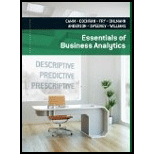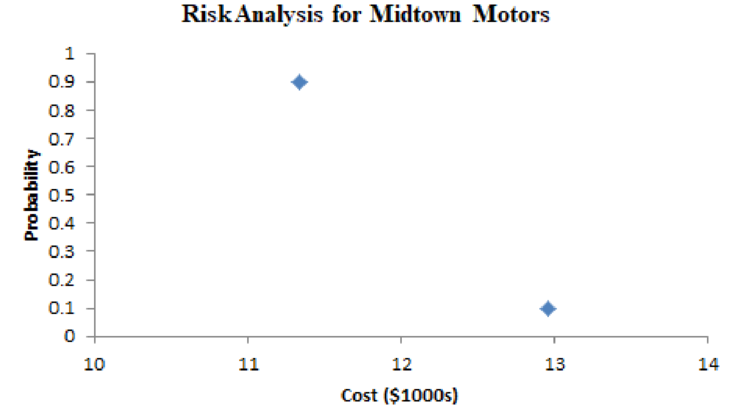
Concept explainers
Amy Lloyd is interested in leasing a new Honda and has contacted three automobile dealers for pricing information. Each dealer offered Amy a closed-end 36-month lease with no down payment due at the time of signing. Each lease includes a monthly charge and a mileage allowance. Additional miles receive a surcharge on a per-mile basis. The monthly lease cost, the mileage allowance, and the cost for additional miles follow:

Amy decided to choose the lease option that will minimize her total 36-month cost. The difficulty is that Amy is not sure how many miles she will drive over the next three years. For purposes of this decision, she believes it is reasonable to assume that she will drive 12,000 miles per year, 15,000 miles per year, or 18,000 miles per year. With this assumption Amy estimated her total costs for the three lease options. For example, she figures that the Hepburn Honda lease will cost her 36($299) + $0.15(36,000 – 36,000) = $10,764 if she drives 12,000 miles per year, 36($299) + $0.15(45,000 – 36,000) = $12,114 if she drives 15,000 miles per year, or 36($299) + $0.15(54.000 – 36,000) = $13,464 if she drives 18,000 miles per year.
- a. What is the decision, and what is the chance
event ? - b. Construct a payoff table for Amy’s problem.
- c. If Amy has no idea which of the three mileage assumptions is most appropriate, what is the recommended decision (leasing option) using the optimistic, conservative, and minimax regret approaches?
- d. Suppose that the probabilities that Amy drives 12,000, 15,000, and 18,000 miles per year are 0.5, 0.4, and 0.1, respectively. What option should Amy choose using the
expected value approach? - e. Develop a risk profile for the decision selected in part (d). What is the most likely cost, and what is its probability?
- f. Suppose that, after further consideration, Amy concludes that the probabilities that she will drive 12,000, 15,000, and 18,000 miles per year are 0.3, 0.4, and 0.3, respectively. What decision should Amy make using the expected value approach?
a.
Find the decision and the chance event faced by Amy.
Explanation of Solution
Here, the decision is based on selecting the best lease option. Thus the least option has three alternatives that are Hepburn Honda, Midtown Motors and Hopkins Automotive.
Here, the chance event is the number of miles Amy will drive.
b.
Find the payoff table for Amy’s problem.
Answer to Problem 3P
Thus, the payoff table for Amy’s problem is given as:
| Actual Miles Driven Annually | |||
| Decision | 12000 | 15000 | 18000 |
| Hepburn Honda | $10,764 | $12,114 | $13,464 |
| Midtown Motors | $11,160 | $11,160 | $12,960 |
| Hopkins Automotive | $11,700 | $11,700 | $11,700 |
Explanation of Solution
The payoff for any combination of alternative and the chance event is the sum of the total monthly charges and total additional mileage cost that is given as follows:
For the Hepburn Honda lease option:
For the Midtown Motors lease option:
For the Hopkins Automotive lease option:
Thus, the payoff table for Amy’s problem is given as:
| Actual Miles Driven Annually | |||
| Decision | 12000 | 15000 | 18000 |
| Hepburn Honda | $10,764 | $12,114 | $13,464 |
| Midtown Motors | $11,160 | $11,160 | $12,960 |
| Hopkins Automotive | $11,700 | $11,700 | $11,700 |
c.
Find the decision using the optimistic, conservative and minimax regret approaches.
Answer to Problem 3P
The Hepburn Honda lease option gives the optimistic approach because it has the smallest minimum profit.
The Hopkins Automotive lease option gives the conservative approach because it has the smallest maximum profit.
The minimax regret is the Hopkins Automotive lease option because it minimizes the maximum regret.
Explanation of Solution
By using the decision tree in Part (a), the maximum and minimum profit based on the decisions Hepburn Honda, Midtown Motors and Hopkins Automotive.
| Decision | Maximum Profit | Minimum Profit |
| Hepburn Honda | $10,764 | $13,464 |
| Midtown Motors | $11,160 | $12,960 |
| Hopkins Automotive | $11,700 | $11,700 |
Optimistic approach:
The optimistic approach evaluates each decision alternative in terms of best payoff that can occur.
The Hepburn Honda lease option gives the optimistic approach because it has the smallest minimum profit (from the above table).
Conservative approach:
The conservative approach evaluates each decision alternative in terms of worst payoff that can occur.
The Hopkins Automotive lease option gives the conservative approach because it has the smallest maximum profit (from the above table).
Minimax Regret approach:
The minimax regret approach is the difference between the payoff associated with a particular alternative and payoff associated with the most decision that would yield the most desirable payoff for a given state of nature.
Regret or opportunity loss table:
| Decision | 12000 | 15000 | 18000 | Maximum Regret |
| Hepburn Honda | $0 | $954 | $1,764 | $1,764 |
| Midtown Motors | $396 | $0 | $1,260 | $1,260 |
| Hopkins Automotive | $936 | $540 | $0 | $936 |
The maximum regret for the decision Hepburn Honda is $1,764, Midtown Motors is $1,260 and Hopkins Automotive is $936.
Here, the Hopkins Automotive lease option has been selected because it minimizes the maximum regret.
d.
Find the expected value approach for the probabilities of 0.5, 0.4 and 0.1.
Answer to Problem 3P
The expected value approach results in Midtown Motors lease option.
Explanation of Solution
The formula to find expected value (EV) of decision alternative di is given as follows:
Here, the expected value for the payoffs associated with each of Amy’s three alternatives:
The expected value approach results in Midtown Motors lease option because it has the minimum expected value of the three alternatives.
e.
Find the most likely cost and its probability using risk analysis.
Answer to Problem 3P
The risk analysis for midtown motors, the most likely cost is $11,160 with the probability of 0.9.
Explanation of Solution
From the data in part (d).
The risk profile for the decision to lease from Midtown Motors is:

From the above risk analysis for midtown motors, the most likely cost is $11,160 with the probability of 0.9.
Here, there are only two unique costs on this graph because for the decision alternative (midtown motors) have two unique payoffs. The payoffs are associated with the three chance outcomes- the payoff (cost) associated with midtown motors lease is same for the two of the chance outcomes.
f.
Find the expected value approach for the probabilities of 0.3, 0.4 and 0.3.
Answer to Problem 3P
The expected value approach results in either Midtown Motors lease option or Hopkins Automotive lease option.
Explanation of Solution
The formula to find expected value (EV) of decision alternative di is given as follows:
Here, the expected value for the payoffs associated with each of Amy’s three alternatives:
The expected value approach results in either Midtown Motors lease option or Hopkins Automotive lease option because both have the same minimum expected value of the three alternatives.
Want to see more full solutions like this?
Chapter 12 Solutions
Essentials Of Business Analytics
 Elementary AlgebraAlgebraISBN:9780998625713Author:Lynn Marecek, MaryAnne Anthony-SmithPublisher:OpenStax - Rice University
Elementary AlgebraAlgebraISBN:9780998625713Author:Lynn Marecek, MaryAnne Anthony-SmithPublisher:OpenStax - Rice University
 Holt Mcdougal Larson Pre-algebra: Student Edition...AlgebraISBN:9780547587776Author:HOLT MCDOUGALPublisher:HOLT MCDOUGAL
Holt Mcdougal Larson Pre-algebra: Student Edition...AlgebraISBN:9780547587776Author:HOLT MCDOUGALPublisher:HOLT MCDOUGAL Algebra: Structure And Method, Book 1AlgebraISBN:9780395977224Author:Richard G. Brown, Mary P. Dolciani, Robert H. Sorgenfrey, William L. ColePublisher:McDougal Littell
Algebra: Structure And Method, Book 1AlgebraISBN:9780395977224Author:Richard G. Brown, Mary P. Dolciani, Robert H. Sorgenfrey, William L. ColePublisher:McDougal Littell



